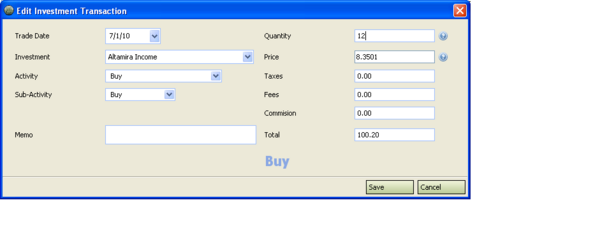Work with an individual investment
From MTHWiki
| Line 24: | Line 24: | ||
== How MyMoney displays Amounts == | == How MyMoney displays Amounts == | ||
| - | Internally MyMoney keeps track of numeric data in a double-precision 64-bit IEEE 754 floating point numbers. However, for display purposes the numbers are approximated as follows | + | Internally MyMoney keeps track of numeric data in a double-precision 64-bit IEEE 754 floating point numbers. However, for display purposes the numbers are approximated as follows: |
| Line 43: | Line 43: | ||
| - | === Quantity | + | === What to enter into Quantity field === |
| + | |||
| + | In the Quantity/Units field, enter the number of Security Units (such as shares) you acquired (or owned) on the date you entered in the Date field. | ||
| + | |||
| + | Use this table to help you decide what to enter for different types of investments: | ||
{| style="width:75%; height:200px; border:1px solid #556B2F;margin: 1em auto 1em auto;" | {| style="width:75%; height:200px; border:1px solid #556B2F;margin: 1em auto 1em auto;" | ||
Revision as of 18:49, 1 July 2010
Contents |
Overview
Transactions such as buys, sells, splits, and options can be manually entered for an investment or, if your brokerage firm supports online banking, you can download this information directly into MyMoney.
Setting up an investment
- Select a Position on which you will be recording a transaction
- In the Position Register select New
- In the New Investment screen, select Activity, such as Buy or Sell.
- Type the Quatity/Price, the Transaction Total will be calculated automatically based on this information
- Provide Taxes and Fees information if you have it
- Press Ok to save this transaction
How MyMoney displays Amounts
Internally MyMoney keeps track of numeric data in a double-precision 64-bit IEEE 754 floating point numbers. However, for display purposes the numbers are approximated as follows:
- Quantity/Units: MyMoney displays the number of shares to four decimal places; for example, 12.0031
displays as 12.0031. It displays exact integers with four trailing zeros, for example 12 will be displayed as 12.0000
- Price: MyMoney displays the price to four decimal places; for example, 12.0031
displays as 12.0031. It displays exact integers with two trailing zeros, for example 12 will be displayed as 12.00
- Total: MyMoney displays the total to two decimal places; for example, 12.0031
displays as 12.00. It displays exact integers with two trailing zeros, for example 12 will be displayed as 12.00
- Taxes, Fees and Commission are displayed similar to Total field.
What to enter into Quantity field
In the Quantity/Units field, enter the number of Security Units (such as shares) you acquired (or owned) on the date you entered in the Date field.
Use this table to help you decide what to enter for different types of investments:
| Security type | Number of shares to enter |
| Stock or mutual fund | The actual number of shares |
| Money market / CD | The total dollar value |
| Bond | Face value of the bond |
| Collectible | The number 1 |
Face value of the bond: Face value of the bond also called the par value, is the value of the bond when it matures. Most bonds have a $1,000 face value. The face value is used to calculate interest payments. For example, a 5 percent bond with a face value of $1,000 pays $50 interest annually


